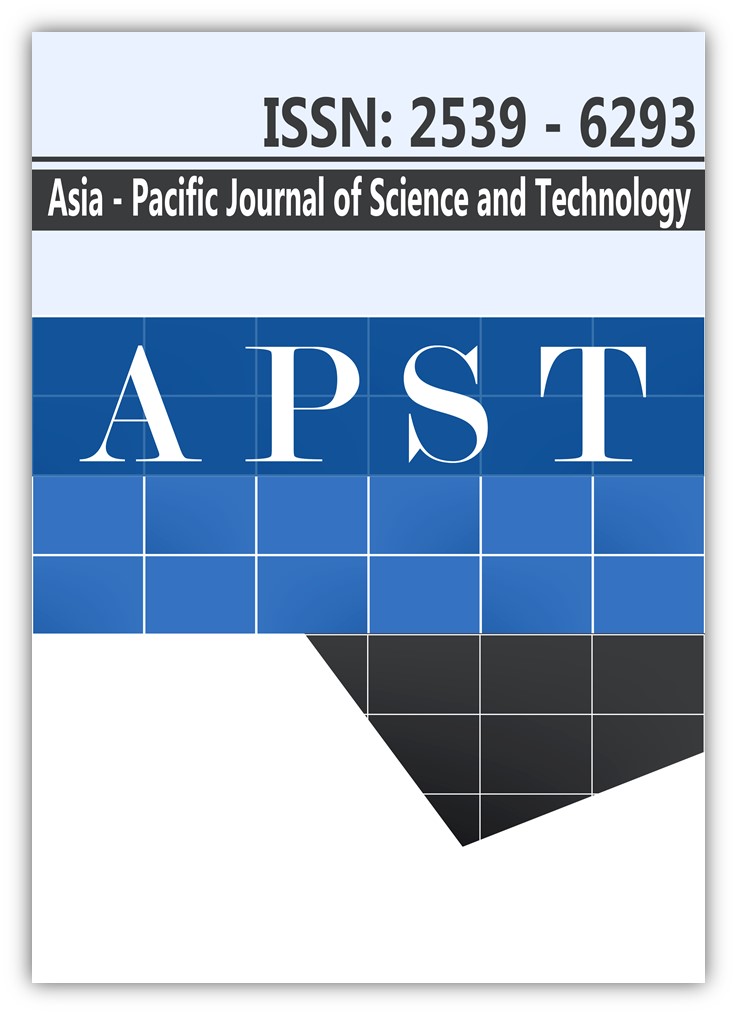Application of aluminum and black rubber heat absorber for solar-base distillation with double slanted-glassed configuration
Main Article Content
Abstract
The aim of this research is to generate a mathematical model and investigate the efficiency of aluminum and black rubber as heat absorber for the Solar-based Double one-Direction slanted-Glass distillation unit (SDDG) by varying the size of the heat absorber. The heat absorber was placed inside the secondary liquid layer of the distillation station. Experiments were conducted by varying the heat absorber plate from 10% to 90% of the second layer’s area. The volume of distilled water was monitored to calculate the efficiency of the distillation unit. Results showed the highest distilled volume of 1.60 litre per day was obtained when the size of aluminum heat absorber was 10%, which produced an average efficiency of 26.34%. Furthermore, a reduction in the distilled volume and efficiency to 0.98 litre per day and 17.3% was observed when the aluminum heat absorber size was increased to 90%. The same trend can be observed for SDDG with black rubber as a heat absorber. However, the efficiency of equivalent size of black rubber is significantly smaller than aluminum due to lower thermal conductivity and material shrinkage when exposed to the solar radiation. The maximum productivity achievable for SDDG with black rubber heat absorber was only 1.17 litre per day. This indicated better heat transfer for smaller heat absorber. The reason is because it is harder for light to pass through the heat absorber with larger area causing the efficiency to drop dramatically as area of heat absorber increased. Polynomial equations were successfully proposed for prediction of productivity from operating time and efficiency from the size of heat absorber.
Article Details
References
[2] Xu Y, Ma J, Liu D, Xu H, Cui F, Wang W. Origami system for efficient solar driven distillation in emergency water supply. Chem Eng J. 2019;356:869–876.
[3] Klungboonkrong V, Phoungchandang S. Microwave drying characteristics and qualities of dried Orthosiphon aristatusleaves. Asia-Pacific J Sci Tech. 2018;23:1–12.
[4] Santosh R, Arunkumar T, Velraj R, Kumaresan G. Technological advancements in solar energy driven humidification-dehumidification desalination systems - A review. J Clean Prod. 2019;207:826–845.
[5] Giwa A, Akther N, Housani AA, Haris S, Hasan SW. Recent advances in humidification dehumidification (HDH) desalination processes: Improved designs and productivity. Renew Sus Energy Rev. 2016;57:929–944.
[6] Jayakody H, Al-Dadah R, Mahmoud S. Computational fluid dynamics investigation on indirect contact freeze desalination. Desalination. 2017;420:21–33.
[7] Kaushal AK, Mittal MK, Gangacharyulu D. Development and experimental study of an improved basin type vertical single distillation cell solar still. Desalination. 2016;398:121–132.
[8] Rajaseenivasan T, Elango T, Kalidasa MK. Comparative study of double basin and single basin solar stills. Desalination. 2013;309:27–31.
[9] Al-Nimr MdA, Qananba KS. A solar hybrid system for power generation and water distillation. A solar hybrid system for power generation and water distillation. Sol Energy. 2018;171:92–105.
[10] Zhu Z, Zheng H, Wang Q, Chen M, Li Z, Zhang B. The study of a novel light concentration and direct heating solar distillation device embedded underground. Desalination. 2018;447:102–119.
[11] An W, Chen L, Liu T, Qin Y. Enhanced solar distillation by nanofluid-based spectral splitting PV/T technique: Preliminary experiment. Sol Energy. 2018;176:146–156.
[12] Zhang Y, Liu L, Li K, Hou D, Wang J. Enhancement of energy utilization using nanofluid in solar powered membrane distillation. Chemosphere. 2018;212:554–562.
[13] Phoungchandang S, Suwannasorn W. Computer model for heat transfer Pasteurization of milk using plate heat exchangers. KKU Res J. 2008;13:561–567.
[14] Chen W, Zou C, Li X, Li L. Experimental investigation of SiC nanofluids for solar distillation system: Stability, optical properties and thermal conductivity with saline water-based fluid. Int J Heat Mass Transf. 2017;107:264–270.
[15] Ming X, Guo A, Wang G, Wang X. Two-dimensional defective tungsten oxide nanosheets as high performance photo-absorbers for efficient solar steam generation. Sol Energy Mater Sol Cells. 2018;185:333–341.
[16] Xu J, Xu F, Qian M, Li Z, Sun P, Hong Z, et al. Copper nanodot-embedded graphene urchins of nearly full-spectrum solar absorption and extraordinary solar desalination. Nano Energy. 2018;53:425–431.
[17] Jumrongkut A. Renewable Energy OS Printing House. 2002.
[18] Çengel YA. Thermodynamics: an engineering approach: Sixth edition. Boston: McGraw-Hill Higher Education.; 2008.
[19] Gugulothu R, Somanchi NS, Devendar G, Deepika PKN. Solar water distillation using different phase change materials. Mater Today: Proceedings. 2017;4(2, Part A):314–321.
[20] Sharshir SW, Ellakany YM, Algazzar AM, Elsheikh AH, Elkadeem MR, Edreis EMA, et al. A mini- review of techniques used to improve the tubular solar still performance for solar water desalination. Process Saf Environ Prot. 2019;124:204–212.
[21] Rassamakin B, Khairnasov S, Zaripov V, Rassamakin A, Alforova O. Aluminum heat pipes applied in solar collectors. Sol Energy. 2013;94:145–154.
[22] Ajani C, Curcio S, Dejchanchaiwong R, Tekasakul P. Influence of shrinkage during natural rubber sheet drying: Numerical modeling of heat and mass transfer. Appl Therm Engine. 2019;149:798–806.
[23] Hasanah RN, Indyanto FR, Maulana E, Suyono H. Solar energy hybrid system for seawater distillation in the coastal regions. Energy Procedia. 2017;143:662–667.
[24] Rahbar N, Esfahani JA. Experimental study of a novel portable solar still by utilizing the heat pipe and thermoelectric module. Desalination. 2012;284:55–61.
[25] Kiwan S, Al-Nimr Md, Abdel Salam QI. Solar chimney power-water distillation plant (SCPWDP). Desalination. 2018;445:105–114.


